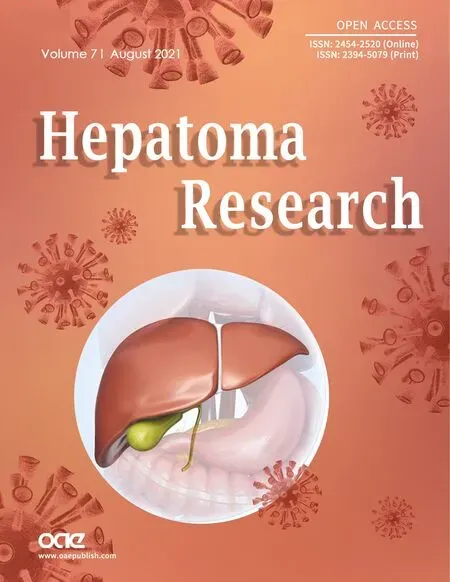Non-invasive detection of liver cirrhosis - the “Essen algorithm”
Matthias Buechter, Guido Gerken
Department of Gastroenterology and Hepatology, University Hospital Essen, University of Duisburg-Essen, Essen 45147,Germany.
The global prevalence of chronic liver disease (CLD) is relatively high and reported to occur in up to 20% of people[1]. Regarding pathogenesis, chronic inflammation leads to hepatocyte destruction and progressive fibrosis of the liver parenchyma. Cirrhosis is the (mostly irreversible) late-stage of scarring of the liver caused by various forms of CLD. Arising complications due to portal hypertension and/or hepatocellular carcinoma are responsible for the dramatically increasing morbidity and mortality among this patient collective[2,3]. Identification of (advanced) fibrosis is relevant in the course of CLD since it delivers prognostic information and assists in establishing treatment priorities in various clinical conditions.However, liver regeneration is highly efficient and fibrosis potentially reversible whilst a certain “point of no return” is not surpassed. Diagnosis and assessment of the severity of fibrosis is therefore important not only to allow risk stratification but also to deliver adequate therapy to avoid progression of CLD[4-6].

Figure 1. The “Essen algorithm”: diagnostic algorithm to rule out cirrhosis in patients with chronic liver disease. TE: Transient elastography; LiMAx: liver maximum capacity.
Today, histological analysis of the liver parenchyma obtained by either percutaneous or laparoscopic biopsy is considered as standard procedure for evaluating the severity of fibrosis. However, due to its invasiveness,this method is impracticable as a widespread tool for screening and monitoring CLD in routine clinical visits[7,8]. Thus, there is a certain requirement for non-invasive techniques to assess the severity of CLD which is reflected by different stages of fibrosis. Therein, different diagnostic instruments have been developed and, in part, implemented in clinical practice and international guidelines. However, proposed serum biomarkers such as aspartate aminotransferase (AST) to alanine aminotransferase (ALT) ratio, ASTto-platelet ratio index, and fibrosis-4 score do not seem to be reliable enough since these enzymes are not exclusively expressed in hepatocytes and influenced by multiple confounders such as acute inflammation,cholestasis, or half-life of the enzymes. In addition, laboratory parameters are compensated and within normal ranges in many cases even though (decompensated) cirrhosis is present and liver function is yet significantly impaired[9-11]. In the early years of this millennium, measurement of liver stiffness by transient elastography (TE, FibroScan) has been introduced and extensively examined. Herein, liver stiffness (or hardness) is evaluated by measuring the velocity of a vibration wave (shear wave). This non-invasive technique has been well-established in the assessment of liver fibrosis with convincing diagnostic accuracy for different stages of fibrosis and cirrhosis of varying etiology. However, TE cannot be used in individuals with ascites, and is associated with higher failure rates or unreliable results in obese patients. Furthermore,diagnostic accuracy of TE is impaired by the state of acute hepatitis and accompanying inflammatory activity[12-15]. More recently, liver maximum capacity (LiMAx) breath test has been developed as a novel noninvasive technique to determine actual enzymatic liver function. It is based on the metabolic turnover of intravenously injected13C-labelled methacetin solution and produces a quantitative measurement of maximal liver function capacity. The test reveals metabolic (dys)function at cellular level in real-time, which correlates with disease severity in various clinical conditions as previously investigated[16-18].
In a currently published work of our group, we evaluated the diagnostic accuracy of the parameters mentioned above in comparison with the “gold standard” determined by histology in a cohort of over 100 individuals suffering from CLD with different etiologies. Histological analysis of liver fibrosis was therefore graduated according to the widely accepted “Desmet scoring system”[19]. Herein, TE and LiMAx showed good diagnostic accuracy in detecting cirrhosis [≥ F4; TE: cut-off 15.0 kilo Pascals, sensitivity 88.9%,specificity 76.9%, positive predictive value (PPV) 47.1%, negative predictive value (NPV) 96.8%, and Youden index 0.66; LiMAx: cut-off 249 μg/h/kg, sensitivity 75.0%, specificity 89.0%, PPV 62.5%, NPV 93.6%, and Youden index 0.64]. However, combination of these two methods significantly increased the diagnostic accuracy to rule out cirrhosis, which we summarized by the novel “Essen algorithm” (sensitivity 88.9%,specificity 84.6%, PPV 0.57, NPV 0.97, and Youden index 0.735; Figure 1)[20]. We firmly believe that this novel algorithm will improve clinical management of patients suffering from CLD.
DECLARATIONS
Authors’ contributions
Wrote the article: Buechter M
Conzeptualized and corrected the article: Gerken G
Availability of data and materials
Not applicable.
Financial support and sponsorship
None.
Conflicts of interest
Both authors declared that there are no conflicts of interest.
Ethical approval and consent to participate
Not applicable.
Consent for publication
Not applicable.
Copyright
© The Author(s) 2021.

